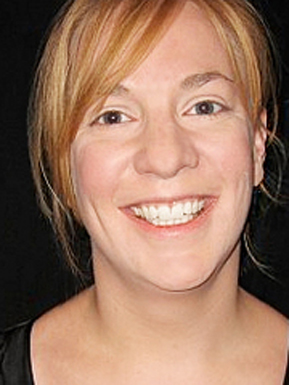Storytelling Journalism Goes Digital
COM conference: how long-form stories can work online

New York Times reporter Amy O’Leary has spent much of her career pursuing this question: in a media-soaked age, how can a single story hold a reader’s attention? That question is at the core of this weekend’s College of Communication annual nonfiction conference. The three-day conference, which has sold out, will explore the role of long-form journalism in the digital age. O’Leary will deliver the conference’s closing keynote address.
Some 32 award-winning journalists, including writer Adam Hochschild, cofounder of Mother Jones and author of the best-selling history book King Leopold’s Ghost, and Oscar-winning documentary film director Alex Gibney (Enron: The Smartest Guys in the Room, The Rise and Fall of Eliot Spitzer) will be on campus to consider the question, particularly in relation to new media.
O’Leary, who worked with the Times’ multimedia department for five years, is a good person to ask. The reporter first set her sights on working at the Times as a teenager in suburban Seattle, but her path was anything but direct: a stint at a daily newspaper in Northfield, Minn., followed by a few years at a software start-up and then a brief job at National Public Radio’s This American Life. In 2007 she landed at the Times as an audio producer, eventually becoming a deputy news editor overseeing online approaches to stories. This January she jumped genres and is now a features reporter at the paper. Although she’s returned to print reporting, O’Leary hasn’t left her multimedia background behind, as a recent conversation with BU Today makes clear.
BU Today: What are the challenges of adapting long-form journalism for multimedia platforms?
O’Leary: The written word is often the most efficient way to tell a story. It’s worked for hundreds of years. When you move into other formats, there should be a compelling reason why. Multimedia is also expensive and time-consuming, so it should justify itself and do something the written word cannot. For example, hearing the emotion in someone’s voice in an audio recording can communicate something that is more difficult to convey in print. The trick is figuring out which formats make sense for the story you are trying to tell. All too often multimedia techniques are used as bells and whistles that end up being distractions from a story.
Is this an ongoing conversation at the Times?
Absolutely. One interesting experiment from last year was a great long-form story by Amy Harmon on adults with autism. The multimedia team embedded quick links into the story so you can mouse over a word or two in the story and see some video. It’s really easy to make those extras just extras. The challenge is how do you make those segues into something essential to the storytelling. I don’t think anyone has nailed that. There’s a ton of experimentation, but no home run example yet.
Why did you move from multimedia to print reporting?
I sought the job out with the proposal of trying to think how the stories would work online from the outset. There’s more opportunity to weave in multimedia if you think of it from the get-go of your reporting. I’ve also been thinking more and more about what our responsibility as reporters is for the life cycle of the story, from its promotion to the conversations it generates.
An example of that is a story I’m working on about the challenges of parenting in a hyperconnected world, such as the various risks that come with kids being online. One of the things we are doing is planning to build a page on the Times website that will be optimized for an internet search, so parents interested in this topic can easily find it in the future. By doing that I hope my reporting will serve parents in a more evergreen way.
What outlets have done a good job of integrating multimedia and long-form stories?
Mediastorm has long been a shop that has been putting out good work. There’s photographer Maisie Crow, who’s done strong work for the Virginia Quarterly Review. The Atavist is another standout.
The Atavist and the Times approach long-form from different angles. With The Atavist, the print piece is the spine. With the Times’ recent piece on hockey player Derek Boogaard, there a was beautifully written print story, but the interactive video was the spine of the narrative. For a story about someone who was in fights on the ice every day that he worked, you want to see what those fights looked like. A video does that better than print. At the same time, it was a story about someone who lost his life. In that respect, the print piece was stronger because it was more elegiac.
There’s a lot of experimentation with multimedia right now, and with experimentation comes failure. It’s hard to find, frankly, a work that sings as great journalism, but makes you feel something is possible that you hadn’t thought of before. People are hungry for a lodestar project they can look to and steal from in a good way.
The opening keynote of the NarrativeArc: Storytelling Journalism Goes Digital conference is at 3 p.m. today, Friday, March 23; the three-day conference ends with O’Leary’s closing keynote on Sunday, March 25, at 12:30 p.m. Events are being held at the Metcalf Trustee Center, One Silber Way, and the School of Management, 595 Commonwealth Ave. A full schedule of events can be found here. The conference is sold out.
Comments & Discussion
Boston University moderates comments to facilitate an informed, substantive, civil conversation. Abusive, profane, self-promotional, misleading, incoherent or off-topic comments will be rejected. Moderators are staffed during regular business hours (EST) and can only accept comments written in English. Statistics or facts must include a citation or a link to the citation.